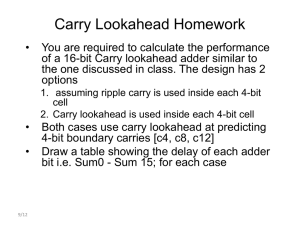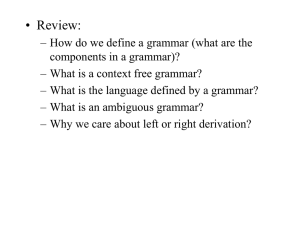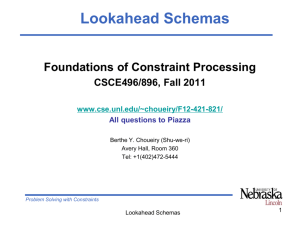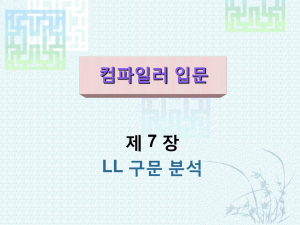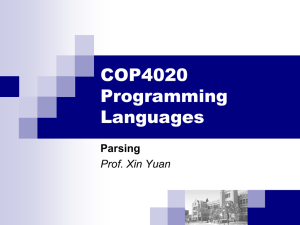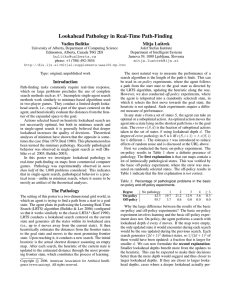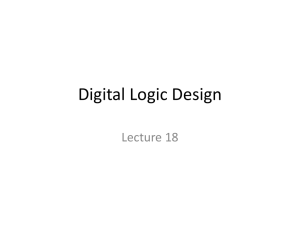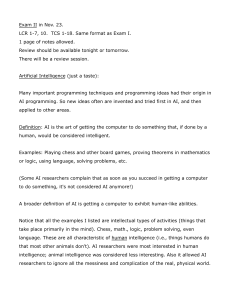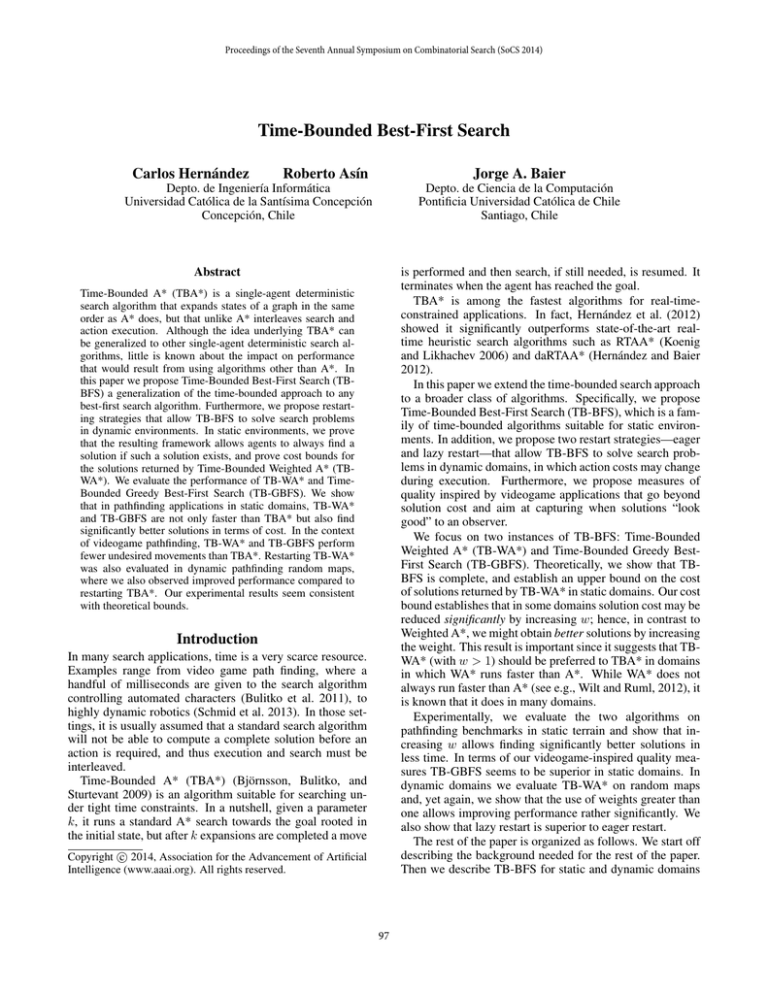
Proceedings of the Seventh Annual Symposium on Combinatorial Search (SoCS 2014)
Time-Bounded Best-First Search
Carlos Hernández
Jorge A. Baier
Roberto Ası́n
Depto. de Ciencia de la Computación
Pontificia Universidad Católica de Chile
Santiago, Chile
Depto. de Ingenierı́a Informática
Universidad Católica de la Santı́sima Concepción
Concepción, Chile
Abstract
is performed and then search, if still needed, is resumed. It
terminates when the agent has reached the goal.
TBA* is among the fastest algorithms for real-timeconstrained applications. In fact, Hernández et al. (2012)
showed it significantly outperforms state-of-the-art realtime heuristic search algorithms such as RTAA* (Koenig
and Likhachev 2006) and daRTAA* (Hernández and Baier
2012).
In this paper we extend the time-bounded search approach
to a broader class of algorithms. Specifically, we propose
Time-Bounded Best-First Search (TB-BFS), which is a family of time-bounded algorithms suitable for static environments. In addition, we propose two restart strategies—eager
and lazy restart—that allow TB-BFS to solve search problems in dynamic domains, in which action costs may change
during execution. Furthermore, we propose measures of
quality inspired by videogame applications that go beyond
solution cost and aim at capturing when solutions “look
good” to an observer.
We focus on two instances of TB-BFS: Time-Bounded
Weighted A* (TB-WA*) and Time-Bounded Greedy BestFirst Search (TB-GBFS). Theoretically, we show that TBBFS is complete, and establish an upper bound on the cost
of solutions returned by TB-WA* in static domains. Our cost
bound establishes that in some domains solution cost may be
reduced significantly by increasing w; hence, in contrast to
Weighted A*, we might obtain better solutions by increasing
the weight. This result is important since it suggests that TBWA* (with w > 1) should be preferred to TBA* in domains
in which WA* runs faster than A*. While WA* does not
always run faster than A* (see e.g., Wilt and Ruml, 2012), it
is known that it does in many domains.
Experimentally, we evaluate the two algorithms on
pathfinding benchmarks in static terrain and show that increasing w allows finding significantly better solutions in
less time. In terms of our videogame-inspired quality measures TB-GBFS seems to be superior in static domains. In
dynamic domains we evaluate TB-WA* on random maps
and, yet again, we show that the use of weights greater than
one allows improving performance rather significantly. We
also show that lazy restart is superior to eager restart.
The rest of the paper is organized as follows. We start off
describing the background needed for the rest of the paper.
Then we describe TB-BFS for static and dynamic domains
Time-Bounded A* (TBA*) is a single-agent deterministic
search algorithm that expands states of a graph in the same
order as A* does, but that unlike A* interleaves search and
action execution. Although the idea underlying TBA* can
be generalized to other single-agent deterministic search algorithms, little is known about the impact on performance
that would result from using algorithms other than A*. In
this paper we propose Time-Bounded Best-First Search (TBBFS) a generalization of the time-bounded approach to any
best-first search algorithm. Furthermore, we propose restarting strategies that allow TB-BFS to solve search problems
in dynamic environments. In static environments, we prove
that the resulting framework allows agents to always find a
solution if such a solution exists, and prove cost bounds for
the solutions returned by Time-Bounded Weighted A* (TBWA*). We evaluate the performance of TB-WA* and TimeBounded Greedy Best-First Search (TB-GBFS). We show
that in pathfinding applications in static domains, TB-WA*
and TB-GBFS are not only faster than TBA* but also find
significantly better solutions in terms of cost. In the context
of videogame pathfinding, TB-WA* and TB-GBFS perform
fewer undesired movements than TBA*. Restarting TB-WA*
was also evaluated in dynamic pathfinding random maps,
where we also observed improved performance compared to
restarting TBA*. Our experimental results seem consistent
with theoretical bounds.
Introduction
In many search applications, time is a very scarce resource.
Examples range from video game path finding, where a
handful of milliseconds are given to the search algorithm
controlling automated characters (Bulitko et al. 2011), to
highly dynamic robotics (Schmid et al. 2013). In those settings, it is usually assumed that a standard search algorithm
will not be able to compute a complete solution before an
action is required, and thus execution and search must be
interleaved.
Time-Bounded A* (TBA*) (Björnsson, Bulitko, and
Sturtevant 2009) is an algorithm suitable for searching under tight time constraints. In a nutshell, given a parameter
k, it runs a standard A* search towards the goal rooted in
the initial state, but after k expansions are completed a move
c 2014, Association for the Advancement of Artificial
Copyright Intelligence (www.aaai.org). All rights reserved.
97
and carry out a theoretical analysis. This is followed by a
description of our videogame-inspired measures of quality.
Then we describe the experimental results, and finish with a
summary and perspectives for future research.
Algorithm 1: Time-Bounded Best-First Search
1 procedure InitializeSearch()
2
sroot ← scurrent
3
Open ← ∅
4
foreach s ∈ S do
5
p(s) = ∞
Time-Bounded Best-First Search
6
7
8
Time-Bounded A* (Björnsson, Bulitko, and Sturtevant
2009) is a real-time search algorithm based on A*. Intuitively, TBA* can be understood as an algorithm that runs an
A* search rooted at sstart whose objective is to reach sgoal .
Unlike A*, TBA* expands a constant number of states between the execution of each action. More specifically, TBA*
alternates a search phase with a movement phase until the
goal is reached. If the goal state has not been reached, in
each search phase it expands k states, and then builds a path
from sstart to the state in Open that minimizes the evaluation function f . The path is built quickly by following parent
pointers, and it is stored in variable path. In the movement
phase, if the current position of the agent, scurrent , is on
path, then the agent performs the action determined by the
state immediately following scurrent on path. Otherwise, it
performs a physical backtrack, moving the agent to its previous position. Physical backtracking is a mechanism that
guarantees that the agent will eventually reach a state in variable path. As soon as such a state is reached the agent will
possibly start moving towards the state believed to be closest
to the goal.
A pseudo-code for Time-Bounded Best-First Search (TBBFS) is presented in Algorithm 1. The parameters are
a search problem (S, A, c, sstart , sgoal ), and an integer k
which we refer to as the lookahead parameter. TB-BFS is
like TBA* but a generic Best-First Search which expands
at most k states per call is run instead of A*. The current
position of the agent is kept in scurrent . Routine InitializeSearch()—which is only called once— initializes the priority of each state. Variable goalFound is set initially to false
and made true as soon as a solution is found by Best-FirstSearch().
Algorithm 1 is equivalent to TBA* when the evaluation
function is defined as f (s) = g(s) + h(s), where h is a
user-given heuristic and g(sstart ) = 0, and g(s) = g(s0 ) +
c(s0 , s) when s was expanded from s0 . We call the algorithm
resulting from using f (s) = g(s) + wh(s) Time-Bounded
WA* (TB-WA*). Finally, we call Time-Bounded GBFS (TBGBFS) the algorithm that results when f (s) = h(s) is used.
p(sroot ) ← f (sroot )
Insert sroot in Open
goalFound ← false
9 function Best-First-Search()
10
expansions ← 0
11
while Open 6= ∅ and expansions < k and
12
13
14
15
16
17
18
19
20
21
22
23
24
25
p(sgoal ) > mint∈Open p(t) do
Let s be the state with minimum priority in Open
Remove s from Open
foreach t ∈ Succc (s) do
Compute f (t) given this newly found path.
if f (t) < p(t) then
p(t) ← f (t)
parent(t) ← s
Insert t in Open
expansions ← expansions + 1
if Open = ∅ then return false
Let sbest be the state with minimum priority in Open.
if sbest = sgoal then goalFound ← true
path ← path from sroot to sbest
return true
26 function MoveToGoal()
27
scurrent ← sstart
28
InitializeSearch()
29
while scurrent 6= sgoal do
30
if goalFound = false and Best-First-Search() = false then
31
return false;
32
33
34
35
36
37
if scurrent is on path then
scurrent ← state after scurrent on path
else
scurrent ← parent(scurrent );
Execute movement to scurrent
return true
38 procedure Main
39
if MoveToGoal() = true then
40
print(“the agent is now at the goal state”)
41
else
42
print(“no solution”)
Theorem 1 TB-BFS will move an agent to the goal state
given a problem P if a solution to P exists. Otherwise, it
will eventually print “no solution”.
Proof: Straightforward from the fact that Best-First Search
returns a solution iff one exists.
The following two lemmas are intermediate results that
allow us to prove an upper bound on the cost of solutions
obtained with TB-WA*. The results below apply to TBA*
but to our knowledge Lemma 1 and Theorem 2 had not been
proven before for TBA*.
In the results below, we assume that P
=
(S, A, c, sstart , sgoal ) is a static search problem, that
TBA-WA* is run with a parameter w ≥ 1 and an admissible heuristic. Furthermore, we assume c∗ is the
cost of a minimum-cost path from sstart to sgoal , that
c+ = max(u,v)∈A c(u, v), and that N (w) is the number of
expansions needed by WA* to solve P .
Properties
Now we analyze a few interesting properties of the algorithms we have just proposed. First, just like TBA*, TB-BFS
always terminates and finds a solution if one exists. This is
an important property since many real-time algorithms (e.g.,
LRTA*) enter an infinite loop on unsolvable problems. Second, we prove an upper bound on the cost of solutions returned by TB-WA*. This bound is interesting since it suggests that by increasing w one might obtain better solutions
rather than worse.
Lemma 1 The cost incurred by an agent controlled by
TB-WA* before goalFound becomes true does not exceed
b N (w)−1
cc+ .
k
98
Proof: N (w) − 1 states are expanded before goalFound
becomes true. If k states are expanded per call to the
search procedure, then clearly b N (w)−1
c is the number of
k
calls for which Best-First-Search terminates without setting
goalFound to true. Each move costs at most c+ , from where
the result follows.
sure the path followed by the agent is always obstacle-free.
In addition this allows us to establish bounds on the cost
incurred by the agent when it is moving forward on a path
that contains the goal (in analogy to Lemma 2).
Algorithm 2: Repeated TB-BFS
1 function MoveToGoal()
2
scurrent ← sstart
3
c ← get initial cost function
4
cprev ← c
5
InitializeSearch()
6
while scurrent 6= sgoal do
7
if goalFound = false and Best-First-Search() = false then
8
return false;
Now we focus on the cost that is incurred after a complete
path is found. The following Lemma is related to a property
enjoyed by TBA* and stated in Theorem 2 by Hernández et
al. (2012).
Lemma 2 The cost incurred by an agent controlled by TBWA* after goalFound has become true cannot exceed 2wc∗ .
Proof: Assume goalFound has just become true. Let π be
the path that starts in sstart , ends in scurrent and that is defined by following the parent pointers back to sstart . Path π
is the prefix of a path to the lowest f -value state in a run of
WA* and therefore is such that c(π) < wc∗ . Now the worst
case in terms of number of movements necessary to reach
the goal is that path and π coincide only in sstart . In this
case, the agent has to backtrack all the way back to sstart .
Once sstart is reached, the agent has to move to the goal
through a path of cost at most wc∗ . Thus the agent may not
incur in a cost higher than 2wc∗ to reach the goal.
9
10
11
12
if scurrent is on path then
scurrent ← state after scurrent on path
else
scurrent ← parent(scurrent );
13
14
15
16
17
Execute movement to scurrent
cprev ← c
c ← get new cost function
if RestartSearch?() then
InitializeSearch()
18
return true
A pseudo-code for Restarting TB-BFS is shown in Algorithm 2. Functions not mentioned are inherited from TBBFS. There are two main differences with TB-BFS: first,
after each movement a new cost function is retrieved, and,
second, search may be restarted after performing a movement. Eager restarting results from implementing RestartSearch?() as returning true if and only if cprev 6= c.
Below we propose, however, lazy restarting strategies,
whereby search is restarted only when needed. Algorithm 3
proposes an implementation for RestartSearch?(). If the
cost of an arc (u, v) increases it checks whether or not
(u, v) is an arc to be followed in the future and if that is
the case, it restarts search. If otherwise, its cost decreases
then it estimates the shortest path through arc (u, v) as
c0 = h(scurrent , u) + c(u, v) + h(v, sgoal ), where h(s, t)
is an estimate of the cost of a shortest path between s and
t. Search is restarted if wc0 is lower than the cost of the
remaining path.
Now we obtain an upper bound on solution cost for TBWA* which follows straightforwardly from the two previous
lemmas.
Theorem 2 The solution cost obtained by TB-WA* is at
most b N (w)−1
cc+ + 2wc∗ .
k
An interesting observation is that empirical observations
show that in many domains, when w is increased, N (w)
decreases exponentially. Thus, when increasing w the first
term of the sum may decrease exponentially while the second may increase only linearly. This suggests that there are
situations in which better- rather than worse-quality solutions may be found when w is increased. As we see later,
this is confirmed by our experimental evaluation. On the
other hand, note that the first term of the bound is less important if k is large or if N (w) does not decrease significantly by increasing w. Thus, we expect less benefits from
running TB-WA* over TBA* if k is large or when search is
carried out in problems in which WA* does not expand significantly fewer nodes than A* in offline mode, which is the
case in some domains (Wilt and Ruml 2012).
Algorithm 3: Lazy Restart Search for WA*
1 function RestartSearch?()
2
for each (u, v) such that cprev (u, v) 6= c(u, v) do
3
if c(u, v) > cprev (u, v) then
4
if v is on path then return true
5
else
6
c0 ← h(scurrent , u) + c(u, v) + h(v, sgoal )
7
c ← cost of the suffix of path after scurrent
8
if wc0 < c then return true
Dynamic Environments via Restarting
TB-BFS is not amenable for dynamic environments. Indeed
since the cost function changes, the path being followed by
the agent may contain two successive states that are not successors anymore. Furthermore, when an arc cost decreases,
there may be a new lowest-cost path, cheaper than the one
being followed so far. When the quality of the solution
matters, following the currently available path may not be
a good decision.
A straightforward approach to dynamic environments is
what we call here eager restarting, which is to restart search
each time the cost function has changed. This way we make
9
return false
The particular way search is restarted allows us to prove
the following result, which is analogous to Lemma 2 for
static domains.
Theorem 3 Let P = (S, A, c0 c1 · · · , sstart , sgoal ) be a
search problem over a dynamic environment, and consider a
run of Repeated TB-WA* with parameter w ≥ 1 and an admissible heuristic. Let cpath be the cost of path with respect
99
to cost function cn , and c∗n be the cost of a cost-minimal path
from scurrent to sgoal . Then cpath ≤ wc∗n .
Search Time As w is increased, search time decreases significantly for lower lookahead values and decreases moderately for higher lookahead values. TB-GBFS is faster
than TBA*, but in most cases TB-WA* is faster than TBGBFS. In the large maps, even for high lookahead values
(> 128) TB-WA*(w = 3) and TB-GBFS are at least six
times faster than TBA*.
In dynamic domains, it is unfortunately not possible to obtain completeness results like the one in Theorem 1 since an
ever changing cost function may eventually block all paths
to the goal.
Overall, results show that TB-WA* (with w > 1) and TBBFS are superior to TBA* in both cost and search time in the
majority of cases, especially when the lookeahead is small
(i.e., when time resources are very limited). This is because
these algorithms require fewer state expansions to reach the
goal compared to TBA*.
Now we focus on the additional quality measures described above. Figure 3 and Figure 4 show the total number
of non-optimal moves and the percentage of back-moves in
BG and ROOMS relative to non-optimal moves. Again we
omit WC from the plots for the same reasons given above.
The following relations hold for all three benchmarks.
Experimental Results
We evaluated variants of TB-BFS on pathfinding tasks in
grid-like static and dynamic terrain. Specifically, we use
eight-neighbor grids since they are often preferred in practice (Bulitko et al. 2011; Koenig and Likhachev 2005). Following existing experimental evaluations (Sun, Koenig, and
Yeoh 2008; Aine and Likhachev 2013), the agent is aware
of cost changes anywhere in the grid. The cost of a horizontal or vertical
movement is 1 and cost of a diagonal move√
ment is 2. The user-given heuristic are the octile distances.
All the experiments were run in a 2.00GHz QuadCore Intel
Xeon machine running Linux.
Non-Optimal Moves We observe the number of nonoptimal moves performed by TB-WA* decreases as w is
increased, except for lookahead 256 in smaller maps and
lookahead 512 or higher for larger maps. For high lookahead values, TBA* performs fewer non-optimal moves
than TB-WA* (w > 1), which is explained by the fact
that TBA* finds an optimal solution requiring fewer agent
moves when the lookahead parameter is high. TB-GBFS
performs fewer non-optimal moves for small lookaheads.
With higher lookahead values TB-GBFS yields a higher
number of non-optimal moves than other algorithms.
Static Environments
We used all 512 × 512-cell maps from the video games
World of Warcraft III (WC3) and Baldurs Gate (BG), and
all the Room maps (ROOMS) available from N. Sturtevant’s
pathfinding repository (Sturtevant 2012). In addition, we
used larger 1024 × 1024-cell maps from the StarCraft game.
Specifically, we used the Cauldron, Expedition, Octopus,
PrimevalIsles, and TheFrozenSea map of size 1014 × 1024
from the video game StarCraft.
For the smaller maps we evaluated five lookahead values: 1, 4, 16, 64, 256, whereas for larger maps we used six
values: 1, 32, 128, 256, 512, 1024. For each map we generated 100 random solvable test cases. For TB-WA* we used
six weight values: 1.0, 1.4, 1.8, 2.2, 2.6, 3.0. All algorithms
have a common code base and use a standard binary heap
for Open. In TB-WA*, ties in Open are broken in favor of
larger g-values. We evaluated the algorithms considering solution cost and the runtime, as measures of solution quality
and efficiency, respectively.
Figure 1 and Figure 2 show performance measures for
BG and ROOM. Since the WC3 plots look extremely similar
when compared to BG, we omit them due to space restrictions. We observe the following relations hold for all maps
regarding solution cost and search time.
Scrubbing TBA* is the algorithm that on average performs
the highest proportion of back-moves compared to TBWA* (w > 1) and TB-GBFS. The tendency is that the
percentage back-moves decrease as w increases, and TBGBFS performs the fewest back-moves among all algorithms.
Overall, if one wants to avoid scrubbing TB-GBFS is
clearly the algorithm of choice. On the other hand TBWA*(w = 3) does significantly less scrubbing than TBA*
(but a little more than TB-GBFS) and in most cases performs
fewer non-optimal moves than other algorithms. Thus TBWA*(w = 3) seems to be the algorithm that achieves the
best balance among both quality measures.
Dynamic Environments
Solution Cost For lookahead values up to 64, solution cost
decreases as w is increased. More significant improvements are observed for lower lookahead values. This is
not surprising in the light of our cost bound (Theorem 2)
. For large lookahead parameters (≥ 128), the value of w
does not affect solution cost significantly. TB-GBFS, on
the other hand, obtains the best-quality solutions among
all algorithms when the lookahead parameter is small. In
fact, in ROOMS TB-GBFS outperforms TBA* by almost
an order of magnitude. With greater lookahead values,
TB-WA*(w = 3) is the algorithm obtaining best-quality
solutions overall.
Following an existing experimental evaluation by Aine and
Likhachev (2013), we evaluated Repeated TB-WA* (henceforth RTB-WA*) with lazy restarting, and six weight values: 1.0, 1.4, 1.8, 2.2, 2.6, 3.0 in 1000 × 1000 grids with a
10% obstacles placed randomly. The original map is given
to the agent before the first search. After 10 moves made
by the agent, (cr/2)% of the originally unblocked cells become blocked and (cr/2)% of the originally blocked cells
become unblocked. We call cr change rate. We tested with
three change rates: 1, 5, and 10. For each change rate we
generated 100 random test cases and computed the average
cost and runtime.
100
BG Maps
Room Maps
30000
10000
2000
Algorithm
)
BF
S
)
TB
G
A*
TB
w
A*
w
TB
(3
.0
)
Algorithm
(2
.6
)
TB
w
A*
(2
.2
)
(1
.8
TB
w
A*
)
(1
.4
A*
w
TB
A*
)
BF
S
TB
G
(3
.0
)
A*
w
TB
TB
w
A*
(2
.6
)
)
TB
w
A*
(2
.2
)
TB
w
A*
(1
.8
)
(1
.4
A*
(1
.0
w
A*
TB
w
TB
w
TB
1000
TB
)
BF
S
-G
)
(3
.0
A*
(2
.6
(2
.2
A*
w
TB
TB
w
A*
(1
.8
TB
w
A*
(1
.4
A*
(1
.0
w
A*
TB
w
TB
)
300
)
500
300
)
1000
500
)
1000
10000
(1
.0
Cost
Cost
2000
Cost (log scale)
6000
4000
4000
Lookahead 1
Lookahead 32
Lookahead 128
Lookahead 256
Lookahead 512
Lookahead 1024
w
6000
Lookahead 1
Lookahead 4
Lookahead 16
Lookahead 64
Lookahead 256
TB
Lookahead 1
Lookahead 4
Lookahead 16
Lookahead 64
Lookahead 256
10000
Large Maps
100000
Algorithm
Figure 1: In static domains, solution cost tends to decrease as w or the lookahead parameter is increased.
BG Maps
Room Maps
3
2
Large Maps
1000
Lookahead 1
Lookahead 4
Lookahead 16
Lookahead 64
Lookahead 256
Runtime (ms) (log scale)
Runtime (ms)
4
Runtime (ms)
20
Lookahead 1
Lookahead 4
Lookahead 16
Lookahead 64
Lookahead 256
10
8
6
4
1
Lookahead 1
Lookahead 32
Lookahead 128
Lookahead 256
Lookahead 512
Lookahead 1024
100
10
2
Algorithm
Algorithm
BF
S
0)
TB
-G
3.
6)
A*
(
-w
TB
-w
A*
(
2.
2)
TB
-w
A*
(
2.
8)
TB
TB
-w
A*
(
1.
4)
A*
(
1.
0)
-w
TB
TB
-w
TB
-G
A*
(
1.
BF
S
0)
3.
6)
A*
(
-w
TB
TB
-w
A*
(
2.
2)
-w
A*
(
2.
8)
1.
TB
TB
-w
A*
(
1.
0)
A*
(
-w
TB
TB
-w
A*
(
1.
BF
S
)
TB
-G
TB
w
A*
(3
.0
)
.6
)
(2
A*
w
TB
w
A*
(2
.2
)
TB
TB
w
A*
(1
.8
)
.4
)
TB
w
A*
(1
.0
(1
A*
w
TB
1
4)
0
0
Algorithm
Figure 2: In static domains, search time typically decreases as w or the lookahead parameter is increased.
BF
S
0)
-G
TB
(3
.
6)
TB
w
A*
(2
.
2)
A*
TB
w
(2
.
8)
A*
TB
w
(1
.
4)
A*
TB
w
(1
.
-G
BF
S
0)
TB
(3
.
6)
TB
w
(2
.
Algorithm
A*
2)
TB
w
A*
8)
(2
.
A*
TB
w
(1
.
4)
A*
w
TB
w
A*
(1
.
0)
TB
TB
w
A*
(1
.
BF
S
0)
-G
TB
A*
(3
.
6)
TB
w
(2
.
2)
(2
.
TB
w
A*
8)
A*
TB
w
(1
.
4)
A*
w
TB
w
A*
(1
.
0)
A*
(1
.
TB
w
TB
Algorithm
10
A*
20
20
100
w
50
1000
TB
500
300
0)
50
1000
(1
.
500
300
Lookahead 1
Lookahead 32
Lookahead 128
Lookahead 256
Lookahead 512
Lookahead 1024
10000
A*
1000
2000
w
2000
Lookahead 1
Lookahead 4
Lookahead 16
Lookahead 64
Lookahead 256
10000
6000
4000
100000
TB
Lookahead 1
Lookahead 4
Lookahead 16
Lookahead 64
Lookahead 256
10000
6000
4000
Large Maps
Number of Non-Optimal Moves (log scale)
Room Maps
Number of Non-Optimal Moves
Number of Non-Optimal Moves
BG Maps
Algorithm
Figure 3: In static domains, as w increases solutions tend to have fewer non-optimal moves, except when the lookahead value
is large.
101
BF
S
)
TB
-G
)
(3
.0
A*
(2
.6
)
A*
(2
.2
TB
w
A*
Algorithm
TB
TB
w
A*
TB
w
TB
w
)
(1
.0
BF
S
)
-G
(3
.0
)
w
TB
w
TB
A*
(2
.6
)
Algorithm
A*
)
TB
w
A*
(2
.2
)
(1
.8
TB
w
A*
(1
.4
)
TB
w
A*
TB
w
TB
w
TB
A*
(1
.0
BF
S
)
-G
)
(3
.0
A*
(2
.6
A*
(2
.2
w
TB
TB
w
A*
(1
.8
A*
(1
.4
TB
w
A*
(1
.0
TB
w
A*
w
TB
)
0%
)
0%
)
10 %
0%
)
10 %
)
20 %
10 %
TB
20 %
30 %
)
30 %
40 %
(1
.8
20 %
40 %
50 %
A*
30 %
50 %
60 %
(1
.4
40 %
60 %
70 %
w
50 %
70 %
TB
60 %
80 %
Lookahead 1
Lookahead 32
Lookahead 128
Lookahead 256
Lookahead 512
Lookahead 1024
80 %
w
Lookahead 1
Lookahead 4
Lookahead 16
Lookahead 64
Lookahead 256
90 %
Percentage of Back Moves
70 %
Large Maps
90 %
Percentage of Back Moves
Lookahead 1
Lookahead 4
Lookahead 16
Lookahead 64
Lookahead 256
80 %
Percentage of Back Moves
Room Maps
100 %
A*
BG Maps
90 %
Algorithm
Figure 4: In static domains, as w increases solutions tend to have fewer back-moves.
Random Maps Change Rate 1
Random Maps Change Rate 5
6000
2000
Cost
)
R
TB
-w
A*
(3
.0
)
(2
.4
)
A*
-w
R
TB
-w
A*
(2
.2
)
R
TB
-w
A*
(1
.8
)
.4
)
-w
R
TB
R
TB
-w
A*
(1
.0
)
A*
(3
.0
)
-w
R
TB
-w
A*
(2
.4
)
(2
A*
Runtime (ms)
2
1
Algorithm
Figure 5: In dynamic domains, solution cost and search time typically decrease as w is increased.
102
R
(3
.0
)
TB
-w
A*
(2
.4
)
R
TB
-w
A*
(2
.2
)
-w
TB
-w
TB
A*
(1
.8
)
(1
.4
)
A*
R
R
TB
-w
A*
(1
.0
)
TB
-w
A*
(3
.0
)
TB
-w
A*
(2
.4
)
R
R
TB
-w
A*
(2
.2
)
-w
TB
R
-w
TB
R
A*
(1
.8
)
(1
.4
)
A*
-w
TB
R
A*
Algorithm
R
Runtime (ms)
A*
-w
TB
5
4
3
0.5
(1
.0
)
.0
)
TB
-w
A*
(3
.4
)
TB
-w
A*
(2
.2
)
TB
-w
A*
(2
.8
)
A*
(1
-w
TB
TB
-w
A*
(1
.4
)
0.5
.0
)
0.5
A*
(1
-w
2
1
Lookahead 1
Lookahead 4
Lookahead 16
Lookahead 64
Lookahead 256
10
5
4
3
1
R
Runtime (ms)
2
Random Maps Change Rate 10
20
Lookahead 1
Lookahead 4
Lookahead 16
Lookahead 64
Lookahead 256
10
5
4
3
Algorithm
Algorithm
Random Maps Change Rate 5
20
Lookahead 1
Lookahead 4
Lookahead 16
Lookahead 64
Lookahead 256
10
R
TB
-w
Algorithm
Random Maps Change Rate 1
20
.2
)
R
TB
-w
A*
(1
.8
)
R
TB
-w
A*
(1
.4
)
R
TB
R
TB
-w
A*
(1
.0
)
A*
(3
.0
)
.4
-w
R
TB
-w
A*
(2
.2
R
TB
-w
A*
(2
.8
R
TB
-w
A*
(1
.4
R
TB
R
TB
-w
A*
(1
.0
(1
A*
-w
R
TB
)
300
)
500
300
)
500
300
)
500
Algorithm
TB
1000
(1
1000
A*
1000
Lookahead 1
Lookahead 4
Lookahead 16
Lookahead 64
Lookahead 256
4000
2000
Cost
2000
Cost
Lookahead 1
Lookahead 4
Lookahead 16
Lookahead 64
Lookahead 256
4000
R
TB
Lookahead 1
Lookahead 4
Lookahead 16
Lookahead 64
Lookahead 256
4000
Random Maps Change Rate 10
6000
R
6000
9
8
7
6
5
4
3
2
.0
)
w
A*
(3
.4
)
w
A*
(2
.2
)
w
A*
(2
.8
)
(1
A*
w
(1
A*
w
(1
.4
)
1
.0
)
Runtime Ratio (Eager wA*/Lazy wA*)
10
A*
w
problems in which WA* expands significantly fewer states
than A*. On the other hand our bound suggests that TBWA* may not yield benefits in domains in which WA*—run
offline—will not yield any improvements over A*.
We implemented and analyzed the performance of timebounded algorithms on pathfinding benchmarks. Our results
confirmed some of the conclusions that can be drawn from
our theoretical bound. It is well known that in pathfinding, WA* may expand significantly fewer nodes than A*.
Consistent with this, in our experiments, Time-Bounded
versions of suboptimal algorithms like Weighted A* and
Greedy Best-First Search produce significantly better solutions than those obtained by TBA*. Improvements are less
noticeable when the lookahead parameter is large, as is also
predicted by theory. A conclusion we draw from our experimental analysis is that TB-WA* seems to be the algorithm that achieves the best balance among quality and performance measures. For instance, TB-WA* (w = 3) with
high lookahead values obtains good solutions very fast, performing almost no scrubbing. TB-WA* seems a good choice
for pathfinding in deployed video games. In our evaluation
in dynamic domains, we also observed savings in time and
cost from using weights and we conclude that lazy restarting
is more efficient than eager restarting.
Our findings are consistent with those obtained by Rivera,
Baier, and Hernández (2013), who also obtain better solutions by using weighted heuristics in the context of
real-time search. Our work adds another piece of evidence that justifies studying the incorporation of weights
into other algorithms (e.g., RIBS; Sturtevant, Bulitko, and
Björnsson, 2010). Other avenues of research include multiagent pathfinding settings (e.g., Standley, 2010), in which
Repeated TB-BFS is applicable.
Change rate 1
Change rate 2
Change rate 5
Change rate 10
Algorithm
Figure 6: Lazy restart significantly outperforms eager restart
in dynamic domains.
First we compare the two restart strategies. For the comparison we use TB-WA* used with lookahead parameter set
to infinity. Figure 6 shows the ratio between the runtime
obtained by lazy and eager restarting for different change
rates and weight values. Lazy restart yields substantially
faster executions. Interestingly, eager restarting has been the
standard strategy when evaluating incremental search algorithms in dynamic domains (Sun, Koenig, and Yeoh 2008;
Aine and Likhachev 2013). This evaluation calls for the use
of lazy restarts in future evaluations of those algorithms.
Figure 5 shows the solution cost and the runtime. For both
change rates cost and runtime decrease when w increases,
for all lookahead values. If w = 1, the best solution cost
is obtained with lookahead 256 whereas best runtime is obtained with lookahead 4. On the other hand, best cost results
are obtained with w > 1; costs are similar across all lookahead values and best runtimes are obtained when lookahead
is equal to 1. We conclude RTB-WA* with lookahead equal
to 1 and w > 1 are the best-performing algorithms because
the agent makes fewer non-optimal moves and restarts are
less frequent.
References
Aine, S., and Likhachev, M. 2013. Truncated incremental
search: Faster replanning by exploiting suboptimality. In
Proceedings of the 27th AAAI Conference on Artificial Intelligence (AAAI).
Björnsson, Y.; Bulitko, V.; and Sturtevant, N. R. 2009.
TBA*: Time-bounded A*. In Proceedings of the 21st International Joint Conference on Artificial Intelligence (IJCAI),
431–436.
Bulitko, V.; Björnsson, Y.; Sturtevant, N.; and Lawrence,
R. 2011. Real-time Heuristic Search for Game Pathfinding. Applied Research in Artificial Intelligence for Computer Games. Springer.
Hart, P. E.; Nilsson, N.; and Raphael, B. 1968. A formal basis for the heuristic determination of minimal cost
paths. IEEE Transactions on Systems Science and Cybernetics 4(2).
Hernández, C., and Baier, J. A. 2012. Avoiding and escaping depressions in real-time heuristic search. Journal of
Artificial Intelligence Research 43:523–570.
Hernández, C.; Baier, J. A.; Uras, T.; and Koenig, S. 2012.
TBAA*: Time-Bounded Adaptive A*. In Proceedings of the
10th International Joint Conference on Autonomous Agents
and Multi Agent Systems (AAMAS), 997–1006.
Conclusions and Perspectives
This paper introduced Time-Bounded Best-First Search
(TB-BFS), a generalization of TBA*, suitable for solving
search problems under real-time constraints. In addition, it
introduced a restarting version of TB-BFS for dynamic environments, and quality measures beyond solution cost aimed
at assessing solutions in the context of videogames.
In static domains we proved TB-BFS returns a solution
if the problem is solvable, and, unlike many other real-time
search algorithms, terminates if the problem has no solution.
In addition, we proved a bound on the cost of solutions returned by TB-WA*. Given a weight w, and if the lookahead
parameter is not too large, our bound suggests that TB-WA*
will be significantly superior to TBA* precisely on search
103
Koenig, S., and Likhachev, M. 2005. Fast replanning
for navigation in unknown terrain. IEEE Transactions on
Robotics 21(3):354–363.
Koenig, S., and Likhachev, M. 2006. Real-time adaptive
A*. In Proceedings of the 5th International Joint Conference
on Autonomous Agents and Multi Agent Systems (AAMAS),
281–288.
Koenig, S., and Sun, X. 2009. Comparing real-time and incremental heuristic search for real-time situated agents. Autonomous Agents and Multi-Agent Systems 18(3):313–341.
Korf, R. E. 1990. Real-time heuristic search. Artificial
Intelligence 42(2-3):189–211.
Pearl, J. 1984. Heuristics: Preintelligent Search Strategies for Computer Problem Solving. Boston, MA, USA:
Addison-Wesley Longman Publishing Co., Inc.
Pohl, I. 1970. Heuristic search viewed as path finding in a
graph. Artificial Intelligence 1(3):193–204.
Rivera, N.; Baier, J. A.; and Hernández, C. 2013. Weighted
real-time heuristic search. In Proceedings of the 11th International Joint Conference on Autonomous Agents and Multi
Agent Systems (AAMAS), 579–586.
Schmid, K.; Tomic, T.; Ruess, F.; Hirschmüller, H.; and
Suppa, M. 2013. Stereo vision based indoor/outdoor navigation for flying robots. In IEEE/RSJ International Conference
on Intelligent Robots and Systems (IROS), 3955–3962.
Standley, T. S. 2010. Finding optimal solutions to cooperative pathfinding problems. In Proceedings of the 25th AAAI
Conference on Artificial Intelligence (AAAI).
Sturtevant, N. R.; Bulitko, V.; and Björnsson, Y. 2010. On
learning in agent-centered search. In Proceedings of the 9th
International Joint Conference on Autonomous Agents and
Multi Agent Systems (AAMAS), 333–340.
Sturtevant, N. 2012. Benchmarks for grid-based pathfinding. Transactions on Computational Intelligence and AI in
Games 4(2):144 – 148.
Sun, X.; Koenig, S.; and Yeoh, W. 2008. Generalized
adaptive A*. In Proceedings of the 7th International Joint
Conference on Autonomous Agents and Multi Agent Systems
(AAMAS), 469–476.
Wilt, C. M., and Ruml, W. 2012. When does weighted A*
fail? In Proceedings of the 5th Symposium on Combinatorial
Search (SoCS).
104

